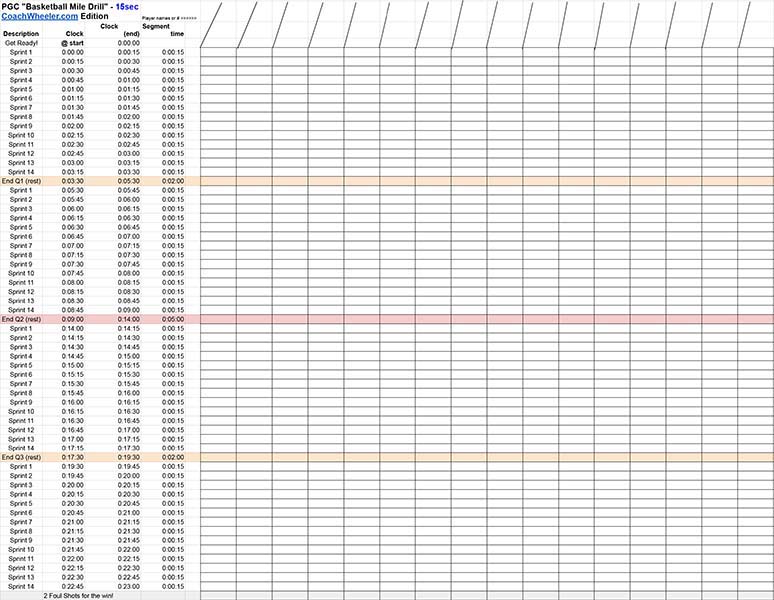First off, let me acknowledge a great idea and the inspiration for this article about getting into basketball shape…
The basketball mile (courtesy of PGC basketball). 
The theory behind the “basketball mile” is to simulate all the running in a full game including the starts/stops, breaks between quarters and more. The reason I am featuring this drill is because it simulates a real game. It also gives you more rest time if you run each segment faster. It might not be an exact match for the running that is done in a game, but it is a pretty good approximation.
QUICK Bonus download for BWM readers…
Coach Wheeler has come up with a “timing sheet” that shows when each segment of this drill should start so you can simply run the game clock continuously and call out start times. The timing sheet also allows you to mark off which players complete each segment. You can even add information such as the winner of each segment. If you want you can record any violations (double dribble, travel or turnover) if you are incorporating a ball into the drill. It’s up to you if you want to add a penalty for mistakes (pushups?).
Click the links below to download the Timing Sheet (using “Save As”) that utilizes 20 second segments or 15 second segments …
[Timing sheet – 20 sec segments] 
[Timing sheet – 15 sec segments]
Ways to make it harder…
One of the key roles of a coach is to challenge the players on their team so they are given an opportunity to grow and improve. The basketball mile is already a pretty challenging drill but how can your team get more value out of doing it?
The PGC article (link here) suggests making the time for each sprint segment shorter (see the 15 second sheet for timing cues) and/or dribbling a ball while sprinting. I might add a few more “twists” to create challenges that will help you in a game.
First, add two free throws at the end and record who makes one or both of them. Free throws at the end of a game (when you are tired) can make the difference between winning and losing. Don’t waste the exhaustion that this drill provides. The timing sheets provide a line at the bottom to collect how each player did on their free throws.
Second, make it more competitive by recording who wins each sprint. Perhaps the player who wins the most sprints takes the last two foul shots for a team win (while individuals can shoot for their own “win”).
Thirdly, how will you start or introduce this drill? How about having two players race each other while the rest of the team watches? If you time them, you can ask the question to the team… is this pace fast enough for us to win our games?
Fourth, can you figure out a way to work in passing as part of the drill? Ideally players would have an opportunity to both dribble and pass based on whatever rules you come up with. Maybe players are paired up so that they pass the ball back and forth as they sprint the first leg and whoever ends up with the ball one step from half-court would have to dribble it back.
Finally, you could record the players who don’t finish the sprint in the time required. They can finish the rest of the sprints “at their leisure” or as additional conditioning work, but those who don’t meet the time targets could be marked on the recording sheet. Can you think of other scenarios? Leave your thoughts in the comments section below!
Final thoughts about How to get in Basketball Shape?
If you ask any basketball coach they would say that the sooner your players get in “basketball shape”, the sooner they will be ready to learn new skills and compete successfully on the court. The “Basketball Mile” is a great tool and there are plenty of ways that it can help your players get in Basketball Shape … the kind of shape that wins games!

 I have started to think about how I might help MOTIVATED basketball players with their summer development plan. In an ideal world, I would gather a group of 8-10 players who would meet at an outside court every morning at sunrise (5am? 6am?) to get a thousand shots up and work on their conditioning, moves and defensive skills.
I have started to think about how I might help MOTIVATED basketball players with their summer development plan. In an ideal world, I would gather a group of 8-10 players who would meet at an outside court every morning at sunrise (5am? 6am?) to get a thousand shots up and work on their conditioning, moves and defensive skills.